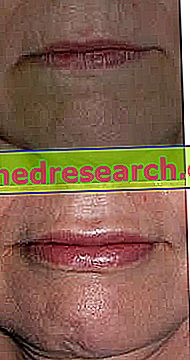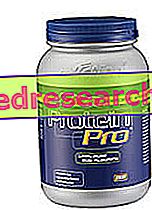What are fillers?
The lip filler is one of the most successful procedures in the field of aesthetics, because it basically allows for an improvement in the volume and shape of the lips. The technique involves the use of different types of materials (of natural or synthetic origin) with different application methods, and, although simple, must satisfy the needs of the patient avoiding complications or adverse reactions to treatment.

Lips
Features and aesthetics
The mouth clearly characterizes each individual: the shape, size and color of the lips are unique features. The mouth is also a focus of attention and for this reason it is essential to keep it at its best; in this sense, cosmetics are a valid aid in treating and characterizing lips.
If there is an asymmetry, a volume problem, a serious blemish, or the appearance of signs of aging, on the lips or on their contour, one can resort to targeted treatments of aesthetic medicine. Such interventions guarantee natural corrections that respect the volumes and the softness of the lips, in addition to their shape.
The daily cosmetic care of the lips: prevention and treatment
Cosmetics are very useful in the daily care of the lips and represent the ideal solution for the different effects that can be achieved. The range of products, which varies from moisturizing or protective balm to stick to the specific plumping product, allows you to keep your lips soft and moisturized, to protect them from UV rays, and to prevent and correct wrinkles and cracks.
Even the make-up can contribute to giving hydration and protection: they play an important barrier function and make the lips firm. In fact, lipsticks and glosses are often enriched with treating and emollient active ingredients (such as: hyaluronic acid, vitamin E, UV filters).
Canons of beauty
The aesthetic canons emphasize the importance in the proportion of the lips and their harmony with the rest of the facial features. There are some parameters to consider:

- The height of the upper lip is generally 6-7 millimeters at its midpoint.
- From this point the vermilion rises up, to the right and to the left, of about 3-5 mm, to form the Cupid's arch.
- The lower lip is always fleshier than the upper one and has an average height of 10 millimeters.
In the case of aesthetic treatments, such as the correction of the volume of the lips, it is important to respect above all the proportion between the upper lip and the lower lip: the first must always be less bulky, to avoid the unnatural "paperino" effect.
blemishes
The blemishes of the lips are due fundamentally related to two aspects:
- to the genetic characteristics of each individual;
- to the natural biological aging process.
In the first case the defects related to the conformation of the lips are of a congenital nature: even the youngest subjects can resort to treatments to resolve imperfections such as the asymmetry of the lips, a thin mouth or an irregular design.
The aging of the labial mucosa generally takes place as we age and is biologically determined by thinning of the skin, loss of hydration and fat, and reabsorption of the mandibular bone and dental alveoli.
Lip aging
The aging of the lips is a natural and biological process and can determine the onset of characteristic imperfections:
- Decrease in volume and softness
- Wrinkles appear on lips and on the contour of the same
- Loss of definition of the design of the lips and / or Cupid's bow
- Lowering of commissures (corners of the mouth)
- Flattening of the filtral columns, the two nasolabial canals.
Filler for the lips
classification and evolution of treatments
There are different types of lip fillers: over the course of time various treatment options have been proposed, which differed due to the different nature of the substances and the injected materials (wax, silicone, products of animal origin). Currently there is a continuous evolution especially for the lip fillers based on hyaluronic acid.
The filling materials can be:
- Permanent materials : polymeric derivatives with alkyl-amidic bonds and polyacrylamide.
General characteristics:
|
- Semi-permanent materials : polylactic acid, collagen associated with polymethylmethacrylate or gel of hyaluronic acid and polymethylmethacrylate.
General characteristics:
|
- Resorbable materials : hyaluronic acid and collagen
General characteristics of resorbable materials:
|
Collagen based filler
The treatment with bovine collagen has represented for many years the aesthetic proposal of reference as regards the facial fillers. The application of the technique - which involves the use of bovine collagen obtained from animals coming from closed and very controlled farms, selected and immune to transmissible diseases - requires a test to establish whether the subject is sensitive or allergic to this component of animal origin ; the allergy test allows to evaluate if the aesthetic treatment can be applied to the patient: a small amount of filler (generally equal to 0.1 ml) is inoculated at the level of the forearm and after a 30-day wait the presence is evaluated less of an adverse reaction to bovine collagen.
An evolution of this type of filler is represented by modern treatments with human collagen or autologous collagen; these fillers involve the injection of dermal material (above all collagen) taken in minimal part from the skin of a donor or of the patient himself and cultivated / modified in the laboratory. In the latter case, the use of autologous collagen eliminates the risk of adverse reactions (it is indicated in highly allergic patients) even if resorption is often very fast.
Filler based on hyaluronic acid
The biotechnological synthesis of hyaluronic acid with different molecular weights (previously extracted from the rooster crest) represented a real turning point in the evolution of lip fillers: it is a synthesis component (not of animal origin) and generally does not require a preventive allergy test to its use, as the aesthetic treatment is safe and effective. The lip fillers based on hyaluronic acid also have a duration of more than two months, unlike the treatments with bovine collagen.
The prolonged duration of treatment is determined by the resorption process (isovolumetric degradation):
- In the case of fillers based on bovine collagen resorption is determined by the degradation of collagen fibers, which are phagocytosed with a consequent decrease in volume.
- Hyaluronic acid, on the other hand, allows the three-dimensional encumbrance of the plant to be maintained for a longer time, since during the process of reabsorption (therefore of degradation of the filler components) water is drawn from the molecules of the residual filler.
Warning!
It is important not to confuse the indications for the labial filler with those of the botulinum toxin : the latter causes a partial paralysis of the mimic musculature and the consequent distension of the treated tissues, without determining a filling of the same. It is typically used, with excellent results, to smooth out fine lines on the forehead.



